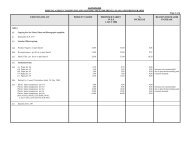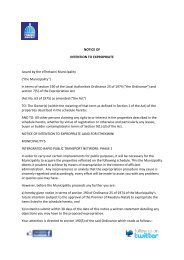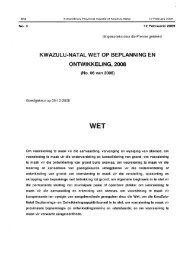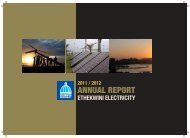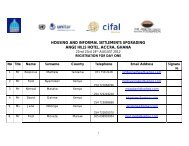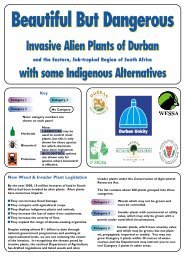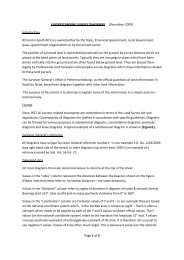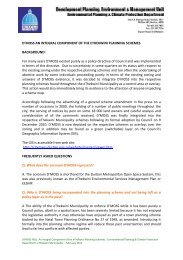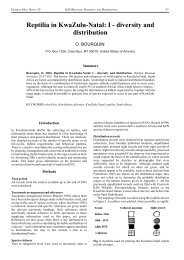Mullin, S. K., Taylor, P. J. & Pillay, N. 2004. Skull size and ... - Durban
Mullin, S. K., Taylor, P. J. & Pillay, N. 2004. Skull size and ... - Durban
Mullin, S. K., Taylor, P. J. & Pillay, N. 2004. Skull size and ... - Durban
You also want an ePaper? Increase the reach of your titles
YUMPU automatically turns print PDFs into web optimized ePapers that Google loves.
MULLIN_08 13/08/04 12:45 Page 30<br />
<strong>Mullin</strong> S. K. et al.<br />
Outline of synomy for the Dasymys genus.<br />
Comparisons between species were based primarily<br />
on significant results (p < 0.05) from the oneway<br />
ANOVA. A map representing this outline is<br />
provided in Fig. 8.<br />
Dasymys capensis Roberts, 1936<br />
Annals of the Transvaal Museum 18: 254.<br />
TYPE LOCALITY. — La Plisante, Wolseley, Western<br />
Cape Province, South Africa (TM).<br />
SPECIMENS EXAMINED. — South Africa (Wolseley,<br />
Knysna, Humansdorp).<br />
DIAGNOSIS. —Dasymys capensis is characterised by a<br />
wide nasal, zygomatic arch <strong>and</strong> braincase breadth. Its<br />
skull structure is most similar to that of D. foxi,<br />
D. incomtus from the KwaZulu-Natal Province <strong>and</strong><br />
D. griseifrons. The ANOVA indicated that the skull of<br />
D. capensis has the most significant differences with<br />
those of D. montanus, D. longipilosus <strong>and</strong> D. rufulus.<br />
REMARKS. — This subspecies should be elevated to<br />
species status based on distinct morphological characteristics<br />
in addition to a restricted <strong>and</strong> isolated distribution<br />
range. Distinguishing characteristics include a significantly<br />
wider zygomatic arch width, braincase breadth<br />
<strong>and</strong> maxillary toothrow than the other specimens.<br />
Dasymys foxi Thomas, 1912<br />
Annals <strong>and</strong> Magazine of Natural History series 8, 9: 685.<br />
TYPE LOCALITY. — Jos Plateau, Panyam, 4000 ft,<br />
Nigeria (USNM).<br />
SPECIMENS EXAMINED. — Nigeria (Panyam, Ugar Jabar).<br />
DIAGNOSIS. — The one-way ANOVA does not show<br />
D. foxi to have any significant distinguishing characteristics<br />
among the 11 species examined. Dasymys foxi has an<br />
overall intermediate <strong>size</strong> when compared to the other<br />
species <strong>and</strong> is generally larger than D. rufulus. Significant<br />
differences between D. foxi <strong>and</strong> D. rufulus were limited<br />
P R O O F<br />
to longer upper toothrow <strong>and</strong> larger skull height in<br />
D. foxi. Otherwise, univariate methods showed that<br />
D. foxi <strong>and</strong> D. rufulus have similar skull <strong>size</strong>s. Its skull is<br />
most similar to material from Eastern (D. griseifrons,<br />
D. medius) <strong>and</strong> southern Africa (D. incomtus <strong>and</strong> D. robertsii)<br />
<strong>and</strong> the most distinct from D. nudipes, D. montanus <strong>and</strong><br />
D. longipilosus, with few measurements in common.<br />
REMARKS. — Dasymys foxi is provisionally being<br />
recognised here as a separate species, but genetic data<br />
are needed to resolve whether it might be a subspecies<br />
of D. rufulus based on some of the multivariate results<br />
presented in this study.<br />
Dasymys griseifrons Osgood, 1936<br />
Field Museum Publications of Zoology 10: 255.<br />
TYPE LOCALITY. — South-west side of Lake Tana, near<br />
Dungulbar, Gojjam, Ethiopia (FMNH). SPECIMENS<br />
EXAMINED. — Ethiopia (Lake Tana, Jigga).<br />
30<br />
APPENDIX 1<br />
DIAGNOSIS. — Although D. griseifrons has a large body<br />
<strong>and</strong> skull <strong>size</strong>, it is generally not as large as those of<br />
D. nudipes, D. capensis or D. shortridgei. It is distinguished<br />
in that it has the widest interorbital constriction<br />
<strong>and</strong> an overall large <strong>size</strong> in terms of both external<br />
<strong>and</strong> cranial measurements. This species has a similar<br />
skull to D. foxi, D. robertsii, D. shortridgei, D. incomtus<br />
<strong>and</strong> D. medius in terms of its larger cranial features.<br />
Dasymys griseifrons was significantly distinct from<br />
D. montanus, D. nudipes <strong>and</strong> D. longipilosus.<br />
REMARKS. — D. griseifrons has a similar skull (in terms<br />
of both <strong>size</strong> <strong>and</strong> shape) to D. medius, its geographically<br />
closest neighboring species, but morphological data<br />
suggest it is distinct. The skull of the second Ethiopian<br />
OTU (Jimma) was more similar to East African material<br />
(D. medius) than was the case for D. griseifrons.<br />
Despite this similarity, we believe that all of the<br />
Ethiopian material belongs within a separate group<br />
(<strong>and</strong> not D. medius), although it is unclear what the<br />
exact relationship is between individuals from Jimma<br />
<strong>and</strong> Lake Tana. For this reason, Jimma is represented<br />
by a question mark in the map provided in Figure 8.<br />
We feel that all Ethiopian material should be examined<br />
further using genetic techniques, as biogeography<br />
would suggest the separation between Ethiopian material<br />
<strong>and</strong> D. medius. Furthermore, Volobouev et al.<br />
(2000) documented two different karyotypic races of<br />
Dasymys occurring in Ethiopia, neither of which were<br />
represented in this study.<br />
Dasymys incomtus (Sundevall, 1847)<br />
Öfversigt af Kungliga Svenska Vetenskapsakademiens<br />
Förh<strong>and</strong>lingar 1846, 2: 120 [1847].<br />
TYPE LOCALITY. — <strong>Durban</strong>, KwaZulu-Natal, South<br />
Africa.<br />
SYNONYMS. — Dasymys incomtus incomtus (Mus<br />
incomtus) Sundevall, 1847. South Africa, “Caffraria<br />
prope Portum Natal” (<strong>Durban</strong>, Natal). Dasymys<br />
incomtus fuscus De Winton 1869: Proceedings of the<br />
Zoological Society, London, (1869): 804. Mazoe,<br />
Mashonal<strong>and</strong>, northeastern Zimbabwe.<br />
SPECIMENS EXAMINED. — The KwaZulu-Natal<br />
Province of South Africa (Vryheid, Dukuduku,<br />
Futululu, Hazelmere Nature Reserve, Richards Bay,<br />
Eshowe, <strong>Durban</strong>, Mfongosi, Karkloof, Kamberg,<br />
Albert Falls, Kilgobbin, Coleford Nature Reserve, Port<br />
St Johns) <strong>and</strong> southeastern Zimbabwe (Matopos, Mt<br />
Selinda, Mazoe <strong>and</strong> Musirizwi River).<br />
DIAGNOSIS. — Dasymys incomtus has an intermediate<br />
skull <strong>size</strong> <strong>and</strong> significantly larger upper toothrow<br />
length when compared to the other species examined.<br />
Although it has a general larger <strong>size</strong> than D. robertsii<br />
(from the Limpopo/Mpumalanga Provinces of South<br />
Africa), none of the characters showed significant<br />
differences. The ANOVA results showed that the skull<br />
is most similar to those of D. foxi, D. robertsii <strong>and</strong><br />
MAMMALIA • 2004 • 68 (2)


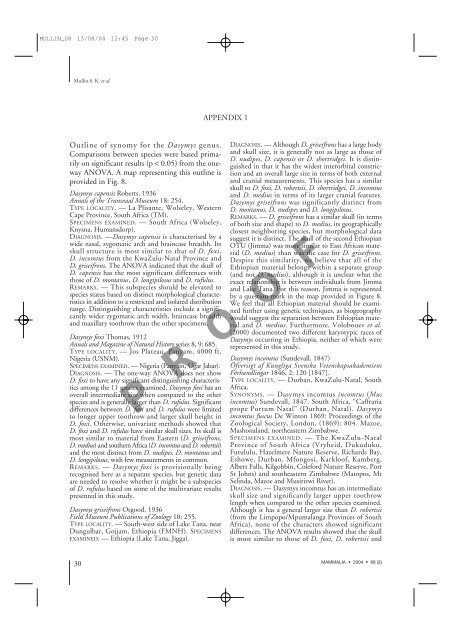
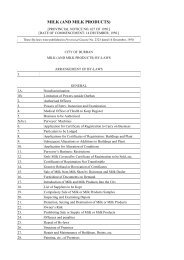
![INK Environmental Sustainability Booklet [19 MB] - Durban](https://img.yumpu.com/22025104/1/190x136/ink-environmental-sustainability-booklet-19-mb-durban.jpg?quality=85)

